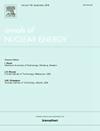Sensitivity analysis of parameters and optimization of produced entropy in a nuclear reactor with equilateral fuel rod arrangement and variable angle turbulators
IF 1.9
3区 工程技术
Q1 NUCLEAR SCIENCE & TECHNOLOGY
引用次数: 0
Abstract
This paper investigates the produced entropy (ENT), including thermal ENT, fluid loss, total ENT, and the Bejan number (Be) in a nuclear reactor with equilateral fuel rod arrangements. The fuel rods are placed within tubes that have diameters varying from 3.1 to 10.1 cm. The rods are vertically positioned in the reactor at a fixed distance, and nanofluids are used to cool them. Turbulator (TUR) blades with angles varying from 0 to 6 degrees and heights from 0 to 13 cm are employed in the nanofluid flow. To enhance the analysis, machine learning methods are used for sensitivity analysis of parameters and optimization of outputs. The results of this study indicate that increasing the tube diameter and the height of the TUR blades leads to an increase in fluid loss ENT, while changes in blade angle have a minimal effect on fluid loss ENT. Increasing the tube diameter and blade length significantly increases thermal ENT and total ENT. Blade angle also has an effect, with thermal ENT decreasing as the angle increases. Changes in blade height, angle, and tube diameter containing the fluid flow result in a 1.8 % variation in the Be. The results demonstrate that tube diameter, blade length, and TUR blade angle are all important parameters in determining the Be in the reactor. An increase in tube diameter significantly raises the Be, while an increase in blade length decreases it. The angle of the blades also affects the Be, with an increase in angle leading to a decrease in the Be.
求助全文
约1分钟内获得全文
求助全文
来源期刊

Annals of Nuclear Energy
工程技术-核科学技术
CiteScore
4.30
自引率
21.10%
发文量
632
审稿时长
7.3 months
期刊介绍:
Annals of Nuclear Energy provides an international medium for the communication of original research, ideas and developments in all areas of the field of nuclear energy science and technology. Its scope embraces nuclear fuel reserves, fuel cycles and cost, materials, processing, system and component technology (fission only), design and optimization, direct conversion of nuclear energy sources, environmental control, reactor physics, heat transfer and fluid dynamics, structural analysis, fuel management, future developments, nuclear fuel and safety, nuclear aerosol, neutron physics, computer technology (both software and hardware), risk assessment, radioactive waste disposal and reactor thermal hydraulics. Papers submitted to Annals need to demonstrate a clear link to nuclear power generation/nuclear engineering. Papers which deal with pure nuclear physics, pure health physics, imaging, or attenuation and shielding properties of concretes and various geological materials are not within the scope of the journal. Also, papers that deal with policy or economics are not within the scope of the journal.
 求助内容:
求助内容: 应助结果提醒方式:
应助结果提醒方式:


